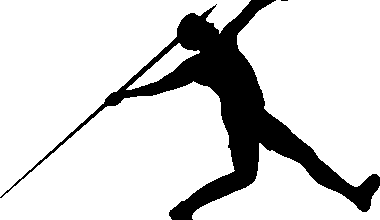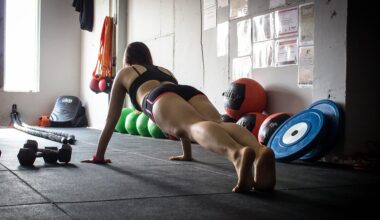The Biomechanics of Throwing Sports
The biomechanical aspects of throwing sports, particularly baseball and javelin, significantly influence performance and injury risk. In baseball, the throwing motion involves coordinated movements from various body segments, including the legs, trunk, and arms. Optimal performance relies on the kinetic chain, where energy is transferred from the lower body through the core and finally to the arm. Understanding this sequence is vital for both players and coaches aiming to enhance throwing efficiency. For javelin, biomechanics plays a crucial role as well; athletes must utilize appropriate angles and velocities to maximize distance. The release angle, velocity of the javelin, and technique impact the projectile’s trajectory. Additionally, external factors like wind conditions and surface type must also be considered for accurate biomechanical analysis. A meticulous assessment helps professionals develop tailored training regimes, reducing injury potential while improving athletic capabilities. Ongoing research in biomechanics enriches our knowledge, allowing for advances in coaching methods and athlete preparation. Thus, grasping these aspects of throwing can be invaluable for coaches and sports physiologists alike, ultimately augmenting performance and prolonging athletic careers.
The Kinematic Chain in Throwing
Throwing in sports is a complex motion requiring a deep understanding of biomechanics and the kinematic chain. In both baseball and javelin, the effective transfer of energy is crucial. Loading the legs during the windup is the foundation of a strong throw. Players should aim to create a powerful push-off, engaging hip flexors and quadriceps for enhanced drive. Proper trunk rotation must follow to facilitate energy transfer, linking lower and upper body movements. The speed and angle of the arm increase when these segments work synchronously. Furthermore, the follow-through stabilizes the body and prevents injuries, as a controlled finish lessens stress on the shoulder and elbow. Various studies show that athletes exhibiting efficient kinematic sequences tend to throw with improved accuracy and speed. To that end, strength and conditioning programs should bolster these critical areas while emphasizing flexibility. Biomechanical data gathered through video analysis or motion capture can refine and optimize an athlete’s throwing mechanics. A thorough investigation helps refine performance over time. Consequently, understanding these elements allows coaches to formulate strategies for training optimization and injury mitigation, ensuring athletes remain competitive.
Injury Prevention Through Biomechanics
Injury prevention in throwing sports is imperative for athlete longevity and performance stability. Pitching, for instance, subjects the throwing arm to immense stresses, sometimes leading to serious conditions like rotator cuff tears or ulnar collateral ligament injuries. A detailed analysis of biomechanics assists in identifying risk factors linked to specific techniques. By analyzing kinematic movements, researchers have established that alterations in mechanics can diminish injury potential. For example, improper shoulder rotation or excessive elbow extension can increase injury risks. Consequently, developing individualized training programs to correct these mechanical flaws is crucial. Integrating strength training focused on the shoulder girdle and scapular stability enhances overall joint health. Moreover, teaching athletes proper mechanics and body awareness reinforces safe motion patterns. Comprehensive warm-up routines that prepare muscles and joints can significantly reduce injury likelihood. Collaborations between sports medicine professionals and coaches foster an environment focused on injury prevention. Lastly, implementing regular assessments can track athlete development while pinpointing arising issues. By actively applying biomechanical principles, it’s possible to establish safer sporting practices that maintain athlete health, ultimately sustaining performance levels throughout competitive seasons.
Biomechanics in Training Programs
Integrating biomechanics into training programs for throwing sports offers athletes substantial benefits. Comprehensive training regimens should not only focus on strength but also on improving mechanics and technique. Coaches can effectively employ video analysis to assess an athlete’s throwing motion. This method allows for personalized feedback, emphasizing necessary adjustments and enhancing skills. Additionally, strength training should target specific muscle groups involved in throwing, such as the shoulders, core, and legs, ensuring optimal performance. Given the dynamic nature of throwing, agility drills and plyometric exercises should also be included. These components facilitate explosive power essential in both baseball and javelin. Furthermore, incorporating flexibility training can enhance range of motion and decrease the risk of injury. Weekly assessments of athletes’ biomechanics help gauge progress and effectiveness. Coaches can refine training strategies based on these evaluations, adapting as needed. Supplements, monitoring fatigue levels, and nutrition should not be neglected. An athlete’s overall health plays a crucial role in their training success. Emphasizing these aspects fosters a holistic approach that boosts performance while ensuring safety through stringent training methods.
Common Biomechanical Faults
Identifying common biomechanical faults in throwing sports like baseball and javelin can greatly enhance athletes’ performance and reduce injury risks. Many athletes exhibit flaws such as poor alignment, which can hinder their ability to throw accurately and powerfully. Ensuring that the body’s segments are in alignment throughout the throwing motion is essential. Additionally, excessive arm extension or incorrect shoulder rotation can lead to strains over time. Athletes often struggle with maintaining optimal throw angles. This is especially true for javelin throwers, who rely heavily on the right release angle for distance. Coaches should focus on guiding athletes to perfect their body mechanics through regular feedback and practice. Valuable tools such as slow-motion video analysis can be used during the assessment process. Furthermore, athlete education on self-awareness regarding their biomechanics can be crucial for improvement. Introducing targeted drills that address these specific faults will foster correct throwing techniques. With consistent practice and correction, athletes can refine their styles. Ultimately, emphasizing these adjustments empowers athletes to reach their full potential while minimizing injury opportunities during their competitive endeavors.
Importance of Recovery
Recovery is a critical yet often underestimated aspect of training in throwing sports. Adequate recovery allows muscles to repair and grow stronger while mitigating fatigue and injury risks. Adequate rest between throwing sessions becomes essential for sustaining performance. Athletes should incorporate active recovery strategies, which may include light exercises, stretching, or yoga to maintain mobility and promote blood circulation. Proper hydration and nutrition significantly impact recovery and aiding muscle repair, ensuring that athletes receive the necessary nutrients during this phase. Additionally, sleep habits play a pivotal role—quality sleep contributes to muscle recovery and cognitive function, allowing athletes to perform their best during training and competitions. Biomechanics can provide insights into optimizing recovery strategies based on individual movement patterns. Understanding how a body moves, including any discomfort or tightness, can guide recovery techniques. Gradually reintroducing intensity in training sessions ensures a balance between workload and recovery. Finally, working alongside sports professionals such as physiotherapists helps athletes craft personalized recovery plans. Therefore, prioritizing recovery reflects a commitment to long-term athletic success and health, fundamentally underlying sustained high performance in specific sports.
Future Research Directions
The field of biomechanics in throwing sports is continuously evolving, with future research promising exciting advances. One area of focus may include the integration of technology and biomechanics, such as wearable devices that monitor athlete performance in real-time. These technologies could provide immediate feedback to athletes and coaches, transforming training methods by allowing for instantaneous adjustments. Furthermore, studying the impact of strength training protocols on biomechanics can reveal insights into performance enhancement. Analysis of data patterns may help identify the most effective training regimens. Additionally, exploring the biomechanical differences between various styles of throwing could prepare coaches to tailor sessions to athletes’ specific needs. Investigating individual responses to different surfaces or equipment can also influence training approaches and techniques. Collaborating with sports scientists on comprehensive longitudinal studies will deepen the understanding of injury mechanisms and help develop effective preventive strategies. Ultimately, the intersection of research and practice will significantly shape throwing sports. As these advancements continue to emerge, they will create a rich resource for athletes striving for excellence, fostering a safer, more productive training environment.


